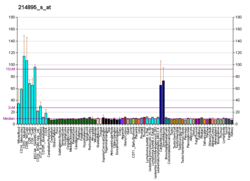ADAM10
| ADAM10 endopeptidase | |||||||||
|---|---|---|---|---|---|---|---|---|---|
| Identifiers | |||||||||
| EC number | 3.4.24.81 | ||||||||
| CAS number | 193099-09-1 | ||||||||
| Databases | |||||||||
| IntEnz | IntEnz view | ||||||||
| BRENDA | BRENDA entry | ||||||||
| ExPASy | NiceZyme view | ||||||||
| KEGG | KEGG entry | ||||||||
| MetaCyc | metabolic pathway | ||||||||
| PRIAM | profile | ||||||||
| PDB structures | RCSB PDB PDBe PDBsum | ||||||||
|
|||||||||
| Search | |
|---|---|
| PMC | articles |
| PubMed | articles |
| NCBI | proteins |
NP_001101
NP_001307499
NP_001101.1
A Disintegrin and metalloproteinase domain-containing protein 10, also known as ADAM10 or CDw156 or CD156c is a protein that in humans is encoded by the ADAM10 gene.
Members of the ADAM family are cell surface proteins with a unique structure possessing both potential adhesion and protease domains. Sheddase, a generic name for the ADAM metallopeptidase, functions primarily to cleave membrane proteins at the cellular surface. Once cleaved, the sheddases release soluble ectodomains with an altered location and function.
...
Wikipedia




